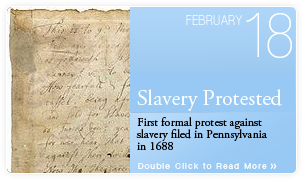First formal protest against slavery filed in Pennsylvania in 1688
On this day in 1688, a community of Quakers living in Germantown, Pennsylvania filed the Germantown Quaker Petition against Slavery. Francis Daniel Pastorius, who had founded Germantown in 1683 as a German-speaking community, wrote the petition for the monthly Quaker Meeting, which is a worship gathering. Basing it on the Golden Rule from the Bible (Do unto others as you would have them do unto you) he urged the Meeting to abolish slavery for the British colony of Pennsylvania. Despite inspiration from the Bible, the document does not reference Jesus or God. It instead uses four men questioning why Christians are allowed to buy, sell and own slaves, in an almost mock sarcastic tone, to prove its point. It also references the Barabary Pirates capturing Christian Europeans as an example of why slavery is not just. It argues that rights should be afforded to any individual regardless of race, religion or ethnicity, putting forth a justification for universal human rights. When presented at the Meeting, it was agreed that the petition was fundamental and just, however too problematic to move forward without further consideration. The Meeting forwarded the petition to the Philadelphia Quarterly Meeting, where it was considered and passed along for the Yearly Meeting. Abolishing slavery for the entire colony was a very controversial action, and the Yearly Meeting forwarded it to the London Yearly Meeting where no action was taken and it was returned to the Philadelphia Yearly Meeting. Slavery continued to be practiced in Pennsylvania; however, increasing numbers of Quakers and Mennonites began protesting and objecting to the practice. In 1776 a proclamation was issued by the Philadelphia Yearly Meeting banning the ownership of slaves. The petition remains the first American document arguing for equal human rights for everyone. It was set aside and forgotten about until 1844 when it was re-discovered, grabbing the attention of the abolitionist movement. A century later it was misplaced again, only to be rediscovered in 2005 in the vault of a Meetinghouse. It is now stored at Haverford College in Quaker and Special Collections.

